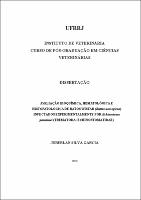Use este identificador para citar ou linkar para este item:
http://rima110.im.ufrrj.br:8080/jspui/handle/20.500.14407/14033| metadata.dc.type: | Dissertação |
| Título: | Avaliação bioquímica, hematológica e histopatológica de ratos wistar (Rattus norvegicus) Infectados experimentalmente por Echinostoma paraensei (Trematoda: Echinostomatidae) |
| Título(s) alternativo(s): | Biochemical, haematological and histopathological evaluation of rats (Rattus norvegicus) experimentally infected with Echinostoma paraensei (Trematoda: Echinostomatidae) |
| metadata.dc.creator: | Garcia, Juberlan Silva |
| metadata.dc.contributor.advisor1: | Silva, Jairo Pinheiro da |
| metadata.dc.contributor.referee1: | Brandolini, Solange Viana Paschoal Blanco |
| metadata.dc.contributor.referee2: | Barros, Luciano Antunes |
| metadata.dc.description.resumo: | O trematódeo Echinostoma paraensei é um parasito de intestino delgado de roedores, sendo seu hospedeiro definitivo natural Nectomys squamipes. No presente estudo, foram utilizadas 50 fêmeas adultas de Rattus norvegicus (Wistar), 35 animais infectados individualmente com 150 metacercárias de E. paraensei (linhagem Sumidouro) e 15 animais não infectados (controle). Semanalmente, sete animais infectados e três animais controle foram submetidos à eutanásia com CO2. O sangue foi coletado para análise hematológica, e o soro obtido por centrifugação, para as determinações de aspartato aminotransferase (AST), alanina aminotransferase (ALT), gamaglutamiltransferase (GGT), fosfatase alcalina (ALKP), bilirrubina, glicose, proteínas totais e frações. Fragmentos de fígado foram coletados para a determinação de glicogênio e para a análise histopatológica. Vermes adultos foram recuperados até a terceira semana de infecção, sendo o maior númro de vermes recuperados na primeira semana. Os hepatócitos apresentavam-se com bordos arredondados e alguns sinais de comprometimento nuclear, infiltração por polimorfonucleares nos sinusóides, vacuolização, discreta infiltração linfoplasmocitária perivascular e periportal com poucas células mononucleares presentes na luz do ducto biliar, alguns hepatócitos estavam hipotrofiados. As análises hematológicas revelaram o desenvolvimento de uma anemia normocítica normocrômica, com anisocitose. Não foram observadas alterações significativas na série branca, havendo apenas uma leucopenia na terceira semana de infecção. Os resultados obtidos são discutidos. |
| Resumo: | The trematode Echinostoma paraensei parasitizes the small intestine of rodents, being its natural definitive host Nectomys squamipes. In spite of the great importance of echinostomatides, there are few studies on morphology, biology and physiology of E. paraensei and its interaction with their intermediate and definitive hosts. In the present study 50 Rattus norvegicus (Wistar),adult females were used, 35 were individually infected with 150 E. paraensei metacercariae (Sumidouro strain) and 15 were maintained uninfected, as control group. Weekly, seven infected and three uninfected rodents were euthanized using CO2.The blood was collected to hematological analysis, and serum obtained by centrifugation and used to aspartate aminotransferase (AST), alanine aminotransferase (ALT), alkaline phosphatase (ALKP), gamma-glutamyl transferase (GGT), bilirubin, glucose, total proteins and fractions determinations. Fragments of liver were collected to glycogen determination and histophatological analysis. Adult worms were loaded until third week of infection, being the higher number of worms loaded at first week of inection. The hepatocytes had rounded edges, with signs of impaired nuclear, mild infiltration of polymorphonuclear and sinusoids slightly expanded. The hepatocytes were vacuolated with discrete perivascular and periportal lymphocytic infiltration. The serum biochemical parameters analyzed were increased at the first week of infection, varying onward. Hematological analysis revealed the development of normocytic and normocromic anaemia with anisocytic alteration. In the white blood cells, only a leukopenia was observed at the third week of infection. The present results are discussed. |
| Palavras-chave: | Echinostoma paraensei Rattus norvegicus hematological biochemical Echinostoma paraensei Rattus norvegicus hematologia bioquímica |
| metadata.dc.subject.cnpq: | Parasitologia |
| metadata.dc.language: | por |
| metadata.dc.publisher.country: | Brasil |
| Editor: | Universidade Federal Rural do Rio de Janeiro |
| metadata.dc.publisher.initials: | UFRRJ |
| metadata.dc.publisher.department: | Instituto de Veterinária |
| metadata.dc.publisher.program: | Programa de Pós-Graduação em Ciências Veterinárias |
| Citação: | GARCIA, Juberlan Silva. Avaliação bioquímica, hematológica e histopatológica de ratos wistar (Rattus norvegicus) infectados experimentalmente por Echinostoma paraensei (Trematoda: Echinostomatidae). 2010. 82 f. Dissertação (Mestrado em Ciências Veterinárias) - Instituto de Veterinária, Universidade Federal Rural do Rio de Janeiro, Serpédica, 2010. |
| metadata.dc.rights: | Acesso Aberto |
| URI: | https://rima.ufrrj.br/jspui/handle/20.500.14407/14033 |
| Data do documento: | 3-Dez-2010 |
| Aparece nas coleções: | Mestrado em Ciências Veterinárias |
Se for cadastrado no RIMA, poderá receber informações por email.
Se ainda não tem uma conta, cadastre-se aqui!
Arquivos associados a este item:
| Arquivo | Descrição | Tamanho | Formato | |
|---|---|---|---|---|
| 2010 - Juberlan Silva Garcia.pdf | Juberlan Silva Garcia | 6.71 MB | Adobe PDF |  Abrir |
Os itens no repositório estão protegidos por copyright, com todos os direitos reservados, salvo quando é indicado o contrário.

